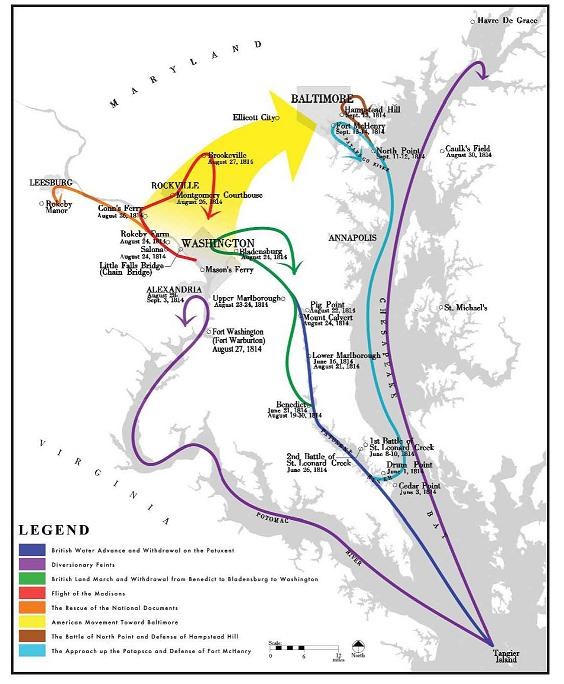
NPS In 1814 the first Fort Washington came to an inglorious end when threatened by a squadron of British ships. In the days afterwards the American Navy would answer the call to arms and make sure that as the British left Alexandria with the spoils of war, they would face a gauntlet of fire during their return to the Chesapeake. 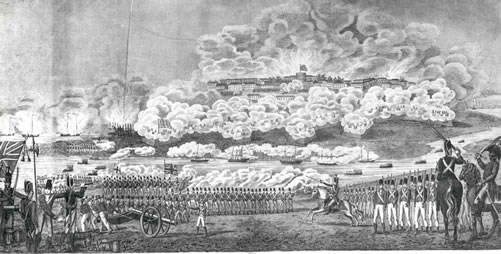
NPS The events leading to the fall On August 16, 1814, at the mouth of the Potomac River, a large fleet of British warships and support vessels under the command of Vice Admiral Alexander Cochrane joined with the British ships already in the Chesapeake area. The plan to attack Washington was formed. On August 17th, Captain James Gordon took seven warships up the Potomac River to Washington to destroy any fortifications along the river. The same day, Vice Admiral Cochrane took the remainder of the fleet and sailed up the Patuxent River to Benedict, Maryland. On August 19,1814 the British Navy landed a force of 5,000 British soldiers and marines at Benedict, Maryland. The British Army marched to Upper Marlboro where they located a number of gunboats that had been commanded by Joshua Barney and had been menacing British ships in the Chesapeake. With no American opposition encountered; the leaders of the expedition, General Robert Ross and Rear Admiral George Cockburn (pronounced co-burn), decided to attack Washington. On August 24, the British Army met an American force compromised of Maryland and District Militia at Bladensburg, on the Northeast outskirts of the District of Columbia. Despite advantage in numbers the militia under the command of General William H. Winder was unable to stop the British advance and ultimately retreated toward Georgetown. By nightfall the British troops had entered the city. After allegedly being fired upon, the British began to burn and loot public buildings. The flames from the burning of the city were visible for 60 miles in the night sky. On the afternoon of August 25, a delegation of prominent citizens from Alexandria came to Washington to surrender their city. Admiral Cockburn responded to their proposal with only saying, "Gentlemen, I have nothing to say till you first tell me whether Captain Gordon is in sight of Alexandria or not." Gordon's squadron had not arrived in time to assist in the attack on Washington. The British Army began to make their way back toward the ships at Benedict leaving Washington in ashes. 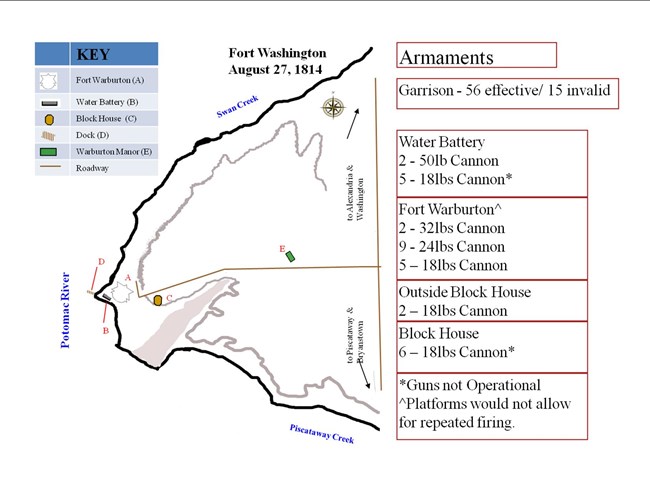
NPS - Gant The situation at the fort The garrison at Fort Washington in August of 1814 consisted of 71 soldiers, 15 who were unable to fight, under the command of US Army Capt. Samuel T. Dyson, who had only assumed command on August 17, the same day the Potomac Squadron entered the river. Because of the threat of the British Army being present in the region Capt. Dyson had never been able to test any of the forts guns and upon assuming command, he found the fort to be poorly equipped; including many guns without implements, uneven platforms and other deficiencies. Fort Washington consisted of 3 sets of guns, The Water Battery, 2- 50pd cannons, 5 -18pd cannons, the 50pd cannons lacked shot, and the 18pd cannons lacked implements. The Fort, 2-32pd cannons, 9-24pd cannons, 5-18pd cannons but uneven platforms meant that these guns could not be repeatedly fired. With the men he had on hand he would be able to operate 5 guns. Up the hill from the fort was a small blockhouse. The blockhouse, was armed with 8-18pd cannon, the 6 inside the blockhouse lacked implements, and leaving 2 guns outside. According to Dyson he had received orders from General Winder (commanding officer for the military district), that if threatened from land he was to abandon the fort and withdraw to Northern Virginia. 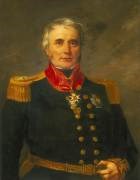
Wiki Commons The day of the fall On the afternoon of August 27, the Gordon's ships were sighted in the river off White House Landing (modern day Fort Belvoir). Gordon had seen the glow of the burning of Washington from over 70 miles away near Marlboro Point, Virginia, and had wanted to return down the river since the battle would be over before they arrived. However, the other squadron leaders encouraged him to continue on. Dyson had previously been informed that a British squadron was sailing up the Potomac River. These were the ships that Cockburn had asked about when in Washington, and now they were in the river on their way toward Alexandria. In the afternoon, Doctor Thomas Marshall (The owner of nearby Marshall Hall) rode into the fort to inform Capt. Dyson of an unfounded rumor that the British Army was marching from the East with their objective being the destruction of Fort Washington. Dyson and his officers believed that the Army that burned Washington would link up with the fleet in the river and then destroy the fort. The British had used repeatedly used such pincer maneuvers in the Chesapeake (Harve De Grace in 1813). Gordon's Fleet consisted of 10 ships including 2 frigates, 3 Bomb ships, and a Rocket ship and a dispatch vessel, with a combined armament of 173 cannons. Fort Washington with its reduced garrison and lack of equipment would only be able to muster 5 guns. At 5:00pm Dyson called his officers to a vote as to what to do. The vote was to withdraw and the order was given for the position to be abandoned based on the intelligence of the moment. The squadron began throwing mortar shells at the fort around 5:30 pm to 6 pm. The powder magazine was lit and sometimes between 6:00pm and 7:30pm just as the first British cannonballs begin to fly over head; The guns were spiked, and the 3,000lbs of black powder in the fort's magazine ignited after some delay, creating an incredible explosion and leveling the fort. Dyson's troops retreated to Mason's Island (modern day Theodore Roosevelt Island). 
LOC The capitulation of Alexandria The next morning, the squadron continued up the river toward Alexandria. The mayor of Alexandria and some other influential citizens sailed down the river to meet Gordon and surrendered the city. Upon meeting the Mayor, Gordon dictated the terms of surrender of the city. The city would surrender all naval stores, agricultural goods, and all ships currently in harbor. Many of the British ships in the squadron made their way to Alexandria, once there the crews set to work emptying the warehouses of goods. On September 2, the British squadron left town with 21 prize vessels, 16,000 barrels of flour, 1,000 hogshead of tobacco, 150 bales of cotton, and $5000 of other goods. 
NPS The Colonial Marines While the squadron was anchored near Alexandria loading up with American goods, one of the British ships (the Anna Maria) anchored just off Fort Washington, in the mouth of Swan Creek. From that location the Anna Maria could serve as a sentry and make sure that American forces did not re-occupy the strategic point that had been abandoned when the fort was destroyed. The Anna Maria also took onboard many runaway slaves. The British Army and Navy had been sending out the call through the slave communities of the region that any slave that could make it to British forces and offered to assist in the war, by offering intelligence or fighting against the Americans would receive a life of freedom somewhere in the British Empire for their service. Upon reaching the Anna Maria these men would be trained with small arms and eventual join a regiment known as the Colonial Marines. Sixty-five slaves would make it to the Anna Maria as it sat anchored in Swan Creek. Today, there are communities in Trinidad, Nova Scotia, and Sierra Leone that can trace their origins to the resettlement of Colonial Marines and their families. 
LOC The stage is set In the aftermath of the burning of Washington the officers of the US Navy stepped into leadership roles around the city. These men would lead the attack on the British fleet as it made its way back to the Chesapeake with the prizes taken from Alexandria. Commodore John Rodgers, who fired the first shots of the war as the Captain of USS President), was the senior officer of the Navy. He had been in Baltimore helping them build defenses against a probable British attack. When he arrived in Washington, took control of the Navy Yard, and was the overall commander of the operations against the Potomac Squadron. 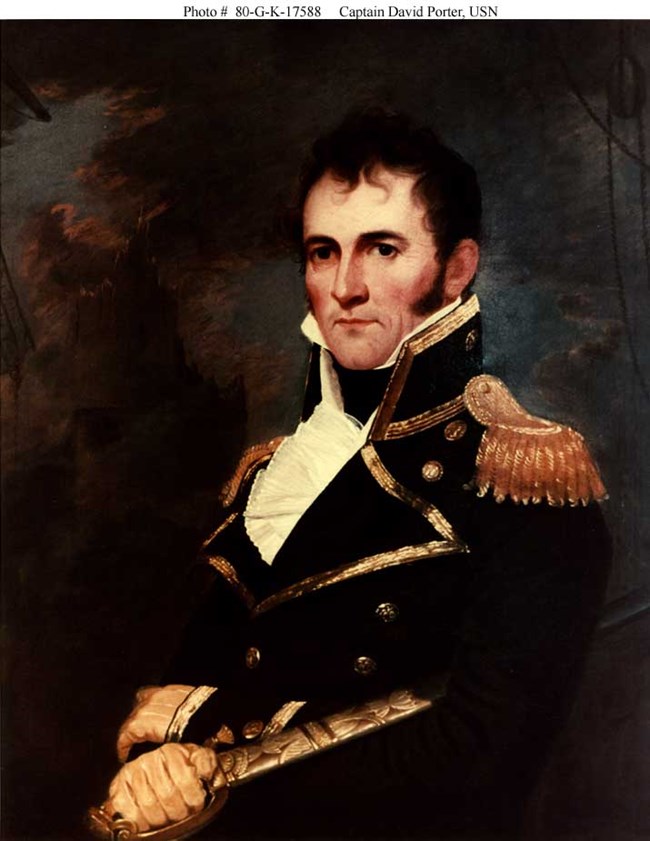
US Navy Capt. David Porter, captain of USS Essex in the South Pacific, had captured many British whale boats. In 1813, the British captured him at Valparaiso, Chile, then released him. Porter was in Baltimore with a crew of over 100 men, had been called to Washington; When Washington was burned, the New Essex was under construction at the Navy Yard. He would be assigned to set up a battery at White House Landing on the neck south of Mount Vernon. 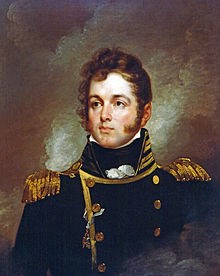
US Navy The hero of Lake Erie, Captain Oliver Hazard Perry, at Put-in-Bay, Ohio had switched flag ships during the battle with his fallen leader's slogan, "Don't give up the ship!", and penned the phrase, "we have met the enemy and they are ours." This unusual tactic would lead to the defeat of the British naval power on Lake Erie. Perry took his crew and Maryland militia to try reestablishing a battery at Fort Washington. If this was not possible, he was to continue south to Indian Head and establish a battery there. 
Sketch by William Bainbrigde Hoff, Naval Historical Center The fight Captain Porter and 2500 Virginia militia, found their way to the defensive positions at White House Landing on Belvoir Neck on the afternoon of September 1st, when a dispatch vessel, Fairy, sailed by to retrieve Gordon and the other squadron vessels. The fight was on. On the morning of September 2, the British began to leave Alexandria. Gordon's squadron was now 29 ships; the original 7, plus Fairy, and 21 prize vessels. The prize vessels were carrying the bulk of 16,000 barrels of flour, 1,000 hogshead of tobacco, 150 bales of cotton, and $5000 of other goods taken from Alexandria warehouses. A bomb vessel and frigate stayed to the rear of the squadron close to Alexandria to protect the squadron's exit. Captain Perry was not able to establish a defensive position at Fort Washington once the squadron ships had dropped down, so his forces travelled down to Indian Head Point to set up another set of batteries. From the Navy Yard, Cmdr. Rodgers dispatched a number of fire ships after the British bomb vessel Devastation grounded near Rozier's Bluff (Fort Foote area), but were unsuccessful in damaging the ship. Upon passing Fort Washington, the squadron ships came under fire of Brigadier General John Hungerford's Virginia militia stationed along the Virginia shoreline from as far north as River Farm (near Fort Hunt) to Belvoir Neck south of Mount Vernon. The largest forces were above White House Landing, under the command of Capt. Porter. Porter had his flag from USS Essex emblazoned with "FREE TRADE & SAILORS RIGHTS". 
NPS - Gant With a wind blowing from the west the British ships were unable to move quickly. From September 3rd until September 5th, the British threw hundreds of mortar shells and solid shot at the Virginians, who responded mainly with innumerable musket shots. The river with alive with the rocket's red glare and bombs bursting in air. At points the British attempted to land ground forces to dislodge the American batteries, each time the American's repulsed the attack sending the British back to their boats. On September 5th, the wind turned allowing the British ships to sail past White House and continue downriver. Upon reaching Indian Head on the evening of September 5th, the battery under Captain Oliver Hazard Perry fired upon the British until all ammunition was expended, lasting only a few hours. The British ships would make it back to the Chesapeake and regroup with the rest of the British Fleet before mounting an attack at Baltimore on September 12, just over a week later. |
Last updated: May 21, 2018
